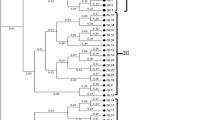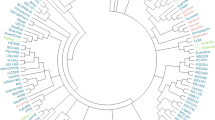Abstract
The American cranberry (Vaccinium macrocarpon) is an endemic domesticated species that has become an economically important commercial fruit crop. The USDA-ARS National Clonal Germplasm Repository (NCGR) houses the national Vaccinium collection, which includes representatives of historical cranberry cultivars and wild-selected germplasm. The objective of this study was to examine the genotypes of 271 cranberry plants from 77 accessions representing 66 named cultivars using 12 simple-sequence repeats to assess clonal purity and cultivar relatedness. Using principal components analysis and neighbour-joining based on estimated genetic distances between individuals, we identified 64 unique genotypes and observed that intracultivar variants (i.e. subclones) existed in the germplasm collection and in the commercial bogs where some accessions originated. Finally, through a comparison of the genotypes of this study with the previous studies, pedigree analysis and the study of the geographic distribution of cranberry diversity, we identified consensus genotypes for many accessions and cultivars. We highlight the important role that the NCGR collection plays for ex situ conservation of cranberry germplasm for future breeders and researchers. The NCGR continues to search for historically relevant cultivars absent from the collection in an effort to preserve these genotypes before they are lost and no longer commercially grown.


Similar content being viewed by others
References
Bassil N. V., Oda A. K. and Hummer K. E. 2009 Blueberry microsatellite markers identify cranberry cultivars. Acta Hortic. 810, 181–186.
Brunet J., Zalapa J. and Guries R. 2016 Conservation of genetic diversity in Slippery elm (Ulmus rubra) in Wisconsin despite the devastating impact of Dutch elm disease. Conserv. Genet. 17, 1001–1010.
Camp W. 1945 The North American blueberries with notes on other groups of Vacciniaceae. Brittonia 5, 203–275.
Chandler F. and Demoranville I. 1958 Cranberry varieties of North America, 513th edition. Massachusetts Agricultural Experimental Station Bulletin.
Dana M. 1983 Cranberry cultivar list. Fruit Var. J. 37, 88–95.
Darrow G. and Camp W. 1945 Vaccinium hybrids and the development of new horticultural material. Bull. Torrey Bot. Club 72, 1–21.
Eck P. 1990 The American cranberry. Rutgers University Press, New Brunswick.
Fajardo D., Morales J., Zhu H., Steffan S., Harbut R., Bassil N. et al. 2013 Discrimination of American cranberry cultivars and assessment of clonal heterogeneity using microsatellite markers. Plant Mol. Biol. Rep. 31, 264–271.
Jombart T. 2008 adegenet: a R package for the multivariate analysis of genetic markers. Bioinforma 24, 1403–1405.
Meilleur B. A. and Hodgkin T. 2004 In situ conservation of crop wild relatives: status and trends. Biodivers. Conserv. 13, 663–684.
Muzzalupo I., Vendramin G. G. and Chiappetta A. 2014 Genetic biodiversity of Italian olives (Olea europaea) germplasm analyzed by SSR markers. Sci. World J. 2014, article ID 296590.
Novy R. and Vorsa N. 1995 Identification of intracultivar genetic heterogeneity in cranberry using silver-stained RAPDs. Hort. Sci. 30, 600–604.
Novy R. G., Kokak C., Goffreda J. and Vorsa N. 1994 RAPDs identify varietal misclassification and regional divergence in cranberry [Vaccinium macrocarpon (Ait.) Pursh]. Theor. Appl. Genet. 88, 1004–1010.
Novy R. G., Vorsa N. and Patten K. 1996 Identifying genotypic heterogeneity in ‘McFarlin’ cranberry: a randomly-amplified polymorphic DNA (RAPD) and phenotypic analysis. J. Am. Soc. Hortic. Sci. 121, 210–215.
Paradis E., Claude J. and Strimmer K. 2004 APE: analyses of phylogenetics and evolution in R language. Bioinformatics 20, 289–290.
Pavek D. S., Lamboy W. F. and Garvey E. J. 2003 Selecting in situ conservation sites for grape genetic resources in the USA. Genet. Resour. Crop Evol. 50, 165–173.
Peakall R. and Smouse P. E. 2006 GENALEX 6: Genetic analysis in Excel. Population genetic software for teaching and research. Mol. Ecol. Notes 6, 288–295.
Peltier G. 1970 A history of the cranberry industry in Wisconsin, Harlo Press, Detroit, Michigan.
Polashock J. and Vorsa N. 2002 Development of SCAR markers for DNA fingerprinting and germplasm analysis of American cranberry. J. Am. Soc. Hortic. Sci. 127, 677–684.
Rogers J. 1972 Measures of genetic similarity and genetic distance. In Studies in genetics VII, pp. 145–153. University of Texas, Publ. No. 7213.
Schlautman B., Covarrubias-Pazaran G., Diaz-Garcia L. A., Johnson-Cicalese J., Iorrizo M., Rodriguez-Bonilla L. et al 2015a Development of a high-density cranberry SSR linkage map for comparative genetic analysis and trait detection. Mol. Breed. 35, 177.
Schlautman B., Fajardo D., Bougie T., Wiesman E., Polashock J., Vorsa N. et al 2015b Development and validation of 697 novel polymorphic genomic and EST-SSR markers in the American cranberry (Vaccinium macrocarpon Ait.). Molecules 20, 2001–2013.
Schlautman B., Covarrubias-Pazaran G., Fajardo D., Steffan S. and Zalapa J. 2016 Discriminating power of microsatellites in cranberry organelles for taxonomic studies in Vaccinium and Ericaceae. Genet. Resour. Crop Evol. 64, 451–466.
Slate J., Marshall T. and Pemberton J. 2000 A retrospective assessment of the accuracy of the paternity inference program CERVUS. Mol. Ecol. 9, 801–808.
Teixeira H., Rodríguez-Echeverría S. and Nabais C. 2014 Genetic diversity and differentiation of Juniperus thurifera in Spain and Morocco as determined by SSR. PLoS One 9, e88996.
R Core Team 2015 R: A language and environment for statistical computing.
Vander Kloet S. 1983a The taxonomy of Vaccinium section Oxycoccus. Rhodora 85, 1–43.
Vander Kloet S. 1983b The taxonomy of Vaccinium section Cyanococcus: a summation. Can. J. Bot. 61, 256–266.
Zalapa J. E., Cuevas H., Steffan S., Zhu H., Senalik D., Zeldin E. et al 2012 Using next generation sequencing approaches for the isolation of simple sequence repeats (SSR) in the plant sciences. Am. J. Bot. 99, 193–208.
Zalapa J. E., Bougie T. C., Bougie T. A., Schlautman B. J., Wiesman E., Guzman A. et al 2015 Clonal diversity and genetic differentiation revealed by SSR markers in wild Vaccinium macrocarpon and Vaccinium oxycoccos. Ann. Appl. Biol. 166, 196–207.
Zhu H., Senalik D., McCown B. H., Zeldin E. L., Speers J., Hyman J. et al 2012 Mining and validation of pyrosequenced simple sequence repeats (SSRs) from American cranberry (Vaccinium macrocarpon Ait.). Theor. Appl. Genet. 124, 87–96.
Acknowledgements
This project was supported by USDA-ARS (project no. 3655-21220-001-00 and 5090-21220-004-00 provided to JZ); WI-DATCP (SCBG Project no. 14-002); National Science Foundation (DBI-1228280); Ocean Spray Cranberries, Inc.; Wisconsin Cranberry Growers Association; Cranberry Institute. B.S. was supported by the Frank B. Koller Cranberry Fellowship for Graduate Students. LRB was supported through the UW Madison, SciMed GRS. GCP was supported by the Consejo Nacional de Ciencia y Tecnología (CONACYT, Mexico). We thank Eric Weisman, Emily Gustin, Tiffany Bougie and Tierney Bougie for their help in the lab. JZ and BS wish to express their gratitude through PS:30:12. We thank all the anonymous reviewers who helped enhance the quality of this paper.
Author information
Authors and Affiliations
Corresponding author
Additional information
Corresponding editor: Manoj Prasad
BS, NB, KH, TS and JZ conceived the research and designed experiments. BS, GCP, LRB and JZ performed genetic analyses and analysed data. BS, JZ, NB, KH and TS interpreted the results and developed discussion points. BS and JZ wrote the paper. JZ oversaw the study. All authors read and approved the manuscript.
Electronic supplementary material
Below is the link to the electronic supplementary material.
Rights and permissions
About this article
Cite this article
Schlautman, B., Covarrubias-Pazaran, G., Rodriguez-Bonilla, L. et al. Genetic diversity and cultivar variants in the NCGR cranberry (Vaccinium macrocarpon Aiton) collection. J Genet 97, 1339–1351 (2018). https://doi.org/10.1007/s12041-018-1036-3
Received:
Revised:
Accepted:
Published:
Issue Date:
DOI: https://doi.org/10.1007/s12041-018-1036-3




